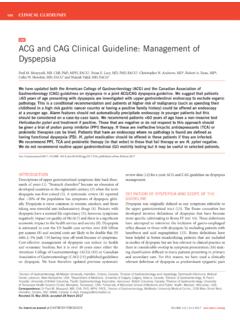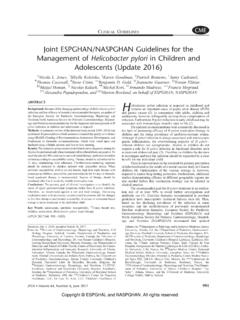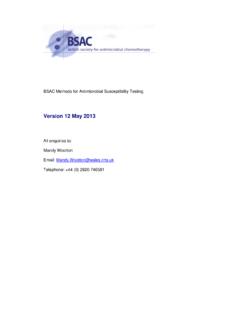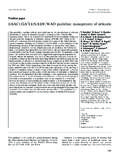Transcription of Gastroenterology 2016;151:51 CONSENSUS …
1 CONSENSUS STATEMENTThe Toronto CONSENSUS for the Treatment ofHelicobacter pyloriInfection in AdultsCarlo A. Fallone,1 Naoki Chiba,2,3 Sander Veldhuyzen van Zanten,4 Lori Fischbach,5 Javier P. Gisbert,6 Richard H. Hunt,3,7 Nicola L. Jones,8 Craig Render,9 Grigorios I. Leontiadis,3,7 Paul Moayyedi,3,7and John K. Marshall3,71 Division of Gastroenterology , McGill University Health Centre, McGill University, Montreal, Quebec, Canada;2 Guelph GI andSurgery Clinic, Guelph, Ontario, Canada;3 Division of Gastroenterology , McMaster University, Hamilton, Ontario, Canada;4 Division of Gastroenterology , Department of Medicine, University of Alberta, Edmonton, Alberta, Canada;5 Department ofEpidemiology, University of Arkansas for Medical Sciences, Little Rock, Arkansas;6 Gastroenterology Service, HospitalUniversitario de la Princesa, Instituto de Investigaci n Sanitaria Princesa (IIS-IP) and Centro de Investigaci n Biom dicaen Red de Enfermedades Hep ticas y Digestivas (CIBEREHD), Madrid, Spain;7 Farncombe Family Digestive HealthResearch Institute, McMaster University, Hamilton, Ontario, Canada.
2 8 Division of Gastroenterology , Hepatology, andNutrition, The Hospital for Sick Children, Departments of Paediatrics and Physiology, University of Toronto, Toronto, Ontario,Canada; and9 Kelowna General Hospital, Kelowna, British Columbia, CanadaThis article has an accompanying continuing medical education activity, also eligible for MOC credit, on page e25. LearningObjective: Upon completion of this examination, successful learners will be able to establish a treatment plan for patients withH & AIMS: helicobacter pyloriinfection isincreasingly difficult to treat. The purpose of these consensusstatements is to provide a review of the literature and specific,updated recommendations for eradication therapy in :A systematic literature search identified studiesonHpyloritreatment. The quality of evidence and strength ofrecommendations were rated according to the Grading ofRecommendation Assessment,Development and Evaluation(GRADE) approach.
3 Statements were developed through anonline platform,finalized, and voted on by an internationalworking group of specialists chosen by the Canadian Asso-ciation of :Becauseofincreasingfailure of therapy, the CONSENSUS group strongly recommendsthat allHpylorieradication regimens now be given for 14days. Recommendedfirst-line strategies include concomitantnonbismuth quadruple therapy (proton pump inhibitor[PPI] amoxicillin metronidazole clarithromycin[PAMC]) and traditional bismuth quadruple therapy (PPI bismuth metronidazole tetracycline [PBMT]). PPI tripletherapy (PPI clarithromycin either amoxicillin ormetronidazole) is restricted to areas with known low clari-thromycin resistance or high eradication success with theseregimens. Recommended rescuetherapies include PBMT andlevofloxacin-containing therapy (PPI amoxicillin levo-floxacin).
4 Rifabutin regimens should be restricted to patientswho have failed to respond to at least 3 prior :Optimal treatment ofHpyloriinfection re-quires careful attention to local antibiotic resistance anderadication patterns. The quadruple therapies PAMC orPBMT should play a more prominent role in eradication ofHpyloriinfection, and all treatments should be given for : helicobacter pylori ; Eradication; Resistance; ProtonPump Inhibitor; Amoxicillin; Bismuth; Clarithromycin; Metro-nidazole; Tetracycline; Levofloxacin; the prevalence ofH pyloriis decreasing insome parts of the world, the infection remains pre-sent in 28% to 84% of subjects depending on the studies in Western nations, which tend to havethe lowest general prevalence,1 4report high proportions ofinfected individuals in certain communities (eg, 38% 75% ofAlaskan or Canadian aboriginal populations).
5 2,3,5 8 Hpyloriis implicated in the development of and itseradication is recommended in the treatment of duodenal orgastric ulcers, early gastric cancer, and gastric mucosa-associated lymphoid tissue lymphomas (in< ).4,9 14 Treatment has been suggested for prevention of gastriccancer in high-risk individuals,11 13,15as well as in patientswith uninvestigated16and functional dyspepsia,17givenevidence that eradication of the infection leads tosustained improvements in symptoms in a proportion ,16,17 The increasing prevalence of antibiotic-resistant strainsofH pylorihas led to reduced success with traditionalHAbbreviations used in this paper:BPAL, bismuth compoundsDprotonpump inhibitorDamoxicillinDlevofloxacin; CAG, Canadian Associationof Gastroenterology ; CI, confidence interval; GRADE, Grading of Recom-mendation Assessment, Development and Evaluation; ITT, intention-to-treat; NNT, number needed to treat; PA, proton pump inhibitorDamoxi-cillin; PAC, proton pump inhibitorDamoxicillinDclarithromycin.
6 PAL,proton pump inhibitorDamoxicillinDlevofloxacin; PAM, proton pumpinhibitorDamoxicillinDmetronidazole; PAMC, proton pump inhibitorDamoxicillinDmetronidazoleDclar ithromycin; PAR, PPID amoxicillinDrifabutin; PBMT, proton pump inhibitorDbismuth compoundsDmetronidazoleDtetracycline; PICO, Population, Intervention, Compar-ator, Outcomes; PMC, proton pump inhibitorDmetronidazoleDclari-thromycin; PPI, proton pump inhibitor; RCT, randomized controlled trial;RD, risk current article 2016 by the AGA Institute0016-5085/$ 2016 ;151:51 24 Proton pump inhibitor (PPI) tripletherapies (a PPI plus two of the following antibiotics: clar-ithromycin, amoxicillin, or metronidazole) for 7 to 10 dayswere once standard and recommended asfirst-linetherapy11 13,25but have become increasingly ineffective,with some studies reporting eradication in less than 50% ,22,26 28 Suboptimal patient compliance may beanother cause of treatment ,29 31It has been suggested that the goal ofH pyloritherapyshould now be eradication in 90% of treated arbitrary threshold is not easily achieved, especiallyin real-world settings.
7 However, the most efficacious ther-apies available should be usedfirst to avoid the cost,inconvenience, and risks associated with treatment of the more common regimens forH pylorieradi-cation include bismuth quadruple therapy (PPI bismuthcompounds metronidazole tetracycline [PBMT]), non-bismuth quadruple therapy (concomitant [PPI amoxicillin metronidazole clarithromycin {PAMC}] orsequential [PPI amoxicillin {PA} followed by PPI metronidazole clarithromycin {PMC}]), PPI triple therapy(PPI amoxicillin clarithromycin [PAC], PMC, or PPI amoxicillin metronidazole [PAM]), and quinolone-containing regimens (PPI amoxicillin levofloxacin[PAL]). Definitions of these and other regimens discussed inthis CONSENSUS paper are shown inTable 1, with suggesteddoses listed inTable increasing prevalence of antibiotic-resistant strainsand evidence of more frequent failures of triple therapiessuggest the need for more effective therapies given for alonger duration (14 days instead of 10 or 7 days) than wererecommended in prior CONSENSUS ,12 For thisreason, as well as the existence of new therapies, theCanadian Association of Gastroenterology (CAG) and theCanadianHelicobacterStudy Group determined that anupdate was needed.
8 The purpose of this CONSENSUS processwas to systematically review the literature relating to themanagement ofH pyloriinfection and to provide specific,updated recommendations for eradication therapy inadults. This CONSENSUS was limited to adults, becauseupdated pediatric recommendations are currently in prog-ress from the European Society for Paediatric Gastroenter-ology, Hepatology and Nutrition and North AmericanSociety for Pediatric Gastroenterology , Hepatology and PurposeThe CONSENSUS development process was initiated in thesummer of 2013 with thefirst meeting of the steering com-mittee and lasted approximately 2 years, with the meeting ofthe full CONSENSUS group taking place in June and SearchesThe Editorial Office of the Cochrane Upper Gastrointestinaland Pancreatic Diseases Group at McMaster UniversityTable for Regimens Used for the Eradication ofH pyloriRecommendationRegimenDefinition (see dose table)First lineRecommendedoptionBismuth quadruple (PBMT)
9 PPI bismuth metronidazolea tetracyclineRecommendedoptionConcomitant nonbismuth quadruple (PAMC)PPI amoxicillin metronidazolea clarithromycinRestricted optionbPPI triple (PAC, PMC, or PAM)PPI amoxicillin clarithromycinPPI metronidazolea clarithromycinPPI amoxicillin metronidazoleaNot recommendedLevofloxacin triple (PAL)PPI amoxicillin levofloxacinNot recommendedSequential nonbismuth quadruple(PA followed by PMC)PPI amoxicillin followed by PPI metronidazolea clarithromycinPrior treatment failureRecommendedoptionBismuth quadruple (PBMT)PPI bismuth metronidazolea tetracyclineRecommendedoptionLevofloxaci n-containing therapy(usually PAL)PPI amoxicillin levofloxacincRestricted optiondRifabutin-containing therapy (usually PAR)PPI amoxicillin rifabutinNot recommendedSequential nonbismuth quadrupletherapy (PA followed by PMC)PPI amoxicillin followed by PPI metronidazolea clarithromycinUndeterminedConcomitant nonbismuthquadruple therapy (PAMC)PPI amoxicillin metronidazolea clarithromycinaTinidazole may be substituted for to areas with known low clarithromycin resistance (<15%) or proven high local eradication rates (>85%) (seestatement 5).
10 CThere is some evidence that adding bismuth to this combination may improve to cases in which at least 3 recommended options have failed (see statement 13).52 Fallone et alGastroenterology Vol. 151, No. 1performed a systematic literature search of the Cochrane Reg-ister, MEDLINE, EMBASE, and CENTRAL for trials publishedfrom January 2008 to December 2013. The main focus of allliterature searches was to identify data on cure rates ofH pyloriinfection. We did not systematically search the literature before2008 because we did not want older data, where higher erad-ication success rates were likely a result of lower antibioticresistance, to confound newer data. Key search termswereHelicobacter pylori , eradication, bismuth, clarithromycin,metronidazole, amoxicillin, levofloxacin, tetracycline, and rifa-butin, among others, to address each of the statements.







